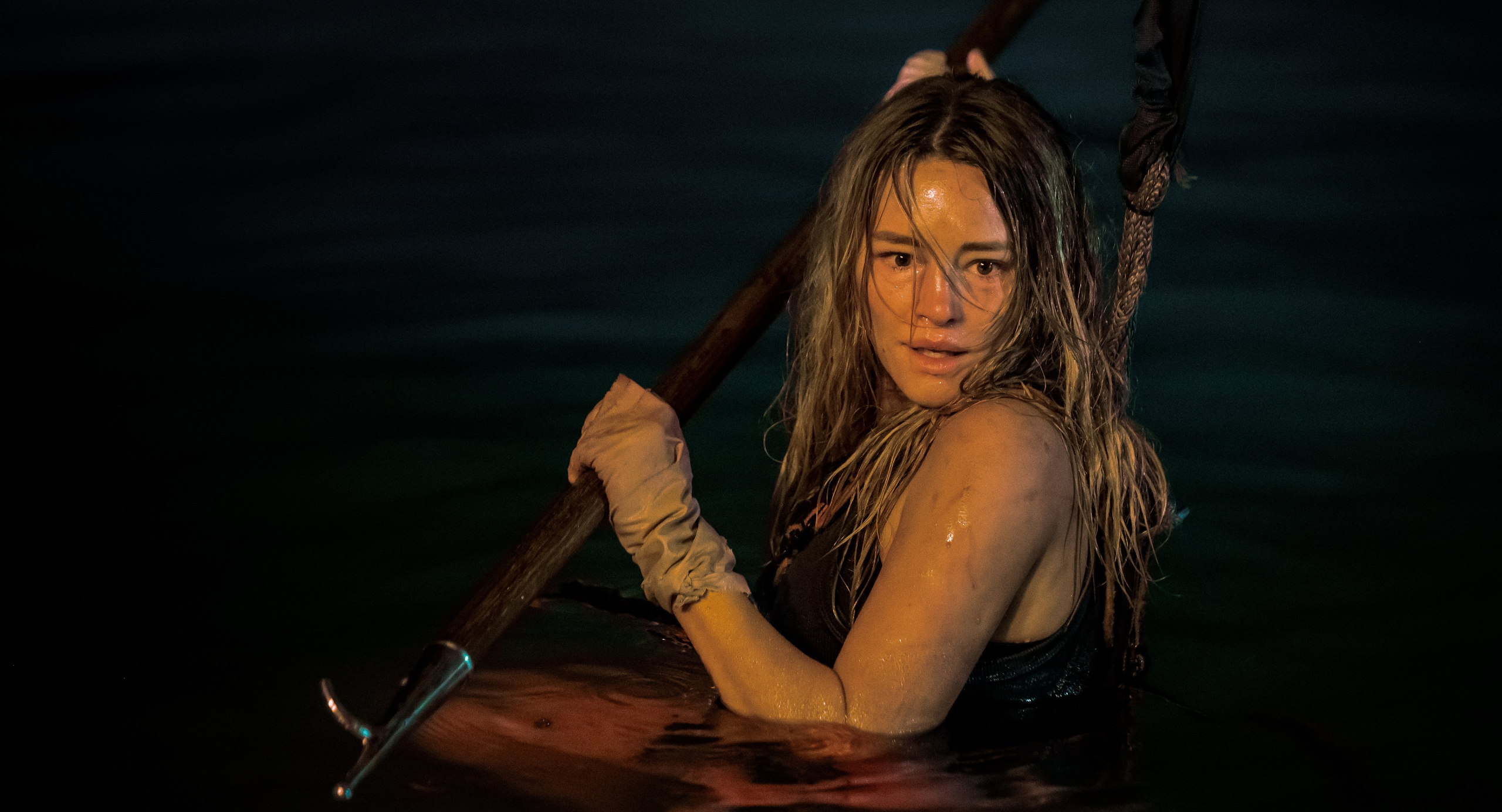Dangerous Animals – Film Review
Published June 8, 2025

In his latest directorial outing, Sean Byrne (The Loved Ones, The Devil’s Candy) crafts a tense, if formulaic, survival horror film with Dangerous Animals—a grim tale of shark-infested seas, human depravity, and gritty female resilience. With a script by Nick Lepard that laces together psychological dread and bloody spectacle, the film stars Hassie Harrison as Zephyr, Jai Courtney as the twisted boat captain Tucker, and Josh Heuston as Moses. Though at times uneven and reliant on genre tropes, Dangerous Animals manages to sink its teeth into the audience with tense set-pieces and an unsettling sense of claustrophobia.
The premise is, at first glance, a familiar one: a young couple—Greg (Liam Greinke) and Heather (Ella Newton)—arrives at Tucker’s Experience, an oceanic shark cage diving adventure off Australia’s Gold Coast. Tucker (Jai Courtney) is a rugged, eccentric captain who regales tourists with stories of surviving a shark attack in his youth—a trauma that allegedly scarred his psyche and shaped his twisted obsession. The film quickly pivots from sunny ocean vistas to a dark survival story as Tucker reveals his true nature, abruptly murdering Greg and kidnapping Heather.
Meanwhile, the story introduces Zephyr (Hassie Harrison), an American drifter seeking solace in the waves. Her brief romance with Moses (Josh Heuston), a friendly local real estate agent, adds a humanizing layer, even if their relationship feels a touch rushed. When Zephyr becomes Tucker’s next victim, the narrative shifts gears into a gritty survival tale, pitting Zephyr’s willpower against Tucker’s sadistic ingenuity.
Hassie Harrison carries the film with a fierce yet grounded performance as Zephyr. She balances vulnerability with steely determination, making her both a sympathetic protagonist and a believable survivor. Harrison’s physical commitment—especially during the film’s numerous fight-or-flight sequences—anchors the narrative even when the script sometimes feels derivative.
Jai Courtney, often typecast in military or action roles, finds a more sinister register as Tucker. He plays the role with a sadistic glee that occasionally veers into caricature, but his rugged intensity and imposing presence are undeniable. Courtney manages to convey Tucker’s backstory—his shark attack as a child—without demanding sympathy, instead fueling his character’s unsettling obsession with the ocean’s apex predators.
Josh Heuston’s Moses brings a likeable everyman quality to the film. His earnestness and genuine concern for Zephyr provide a needed contrast to the film’s otherwise relentless menace. Although the character development feels thin at times, Heuston’s performance gives Moses enough heart to make his peril believable.
Sean Byrne’s direction shines most in his ability to wring tension from claustrophobic environments: the cramped quarters of Tucker’s boat, the blood-tinged ocean, and the ominous mechanical whir of a shark cage. The cinematography by Shelley Farthing-Dawe captures both the beauty and the dread of open water, with underwater shots that exploit the primal fear of the unseen lurking beneath. The blood-soaked, rusted cage—one of Tucker’s signature “tools”—becomes a chilling symbol of captivity and violence.
Nick Lepard’s script, however, leans heavily on genre conventions: the sadistic killer with a dark past, the resourceful final girl, the reluctant hero, and the inevitable showdown between predator and prey. While these beats are executed competently, they offer little innovation. The plot’s structure feels predictable, leaving few surprises for seasoned horror fans.
Where Dangerous Animals excels is in its visceral moments. The film’s shark attack sequences are choreographed with stomach-turning realism, making excellent use of practical effects and sound design. The thrashing water, the muffled screams, and the eerie calm after a feeding frenzy all contribute to an atmosphere of dread that lingers.
Yet, the film’s reliance on shock value—shark attacks, sudden violence, and sadistic games—can feel repetitive. While Byrne effectively builds tension, some sequences drag on, diminishing their impact. The script struggles to balance character development with its commitment to carnage, often leaving secondary characters feeling one-dimensional.
Beneath the blood and gore, Dangerous Animals explores themes of survival, resilience, and the human capacity for cruelty. Tucker’s transformation from shark attack survivor to predator himself is a compelling, if underdeveloped, thread. The idea that trauma can breed monstrosity offers a psychological angle that could have been more deeply mined.
Zephyr’s evolution from drifter to survivor forms the film’s emotional backbone. Her journey—escaping captivity, outsmarting her captor, and facing her fears—feels earned, even if her arc follows a familiar final girl trajectory. Moses’s devotion to finding Zephyr adds a touch of humanity, though his character feels underwritten compared to the stronger arcs of Zephyr and Tucker.
Dangerous Animals is a competent survival horror that benefits from strong performances and a relentlessly tense atmosphere. Hassie Harrison shines as a resilient protagonist, and Jai Courtney delivers a memorably menacing villain. Sean Byrne’s direction captures the claustrophobic dread of being trapped at sea, while Nick Lepard’s script, though formulaic, hits the necessary genre beats with confidence.
